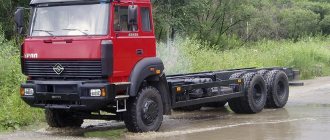How many cubic meters of firewood are in a tractor trailer?
Its capacity is 5.65 cubic meters. Having stacked the firewood with a slide, it can accommodate 7.65 m3. New carts have double sides already from the factory.
Interesting materials:
In which organ is the hormone produced? In which department should contracts be stored? In which hemisphere is India located? In what order should I play the Destiny 2 campaigns? Which product has the most casein? In which section of the balance sheet should fixed assets be shown? What region is Great Britain located in? In what mode can you add notes to a slide? In what mode should you iron a shirt? When should you take statins?
GAZ-53: history
Serial production of the GAZ-53 began in 1961. Over the next thirty-odd years, the car was produced in various versions, changing the indices in the name. In 1993, serial production of the GAZ-53 on the GAZ-53-12 model was completed. The cars were produced at the facilities of the Gorky plant. The equipment belongs to the third generation of GAZ.
Over the years of serial production, more than four million units of equipment were produced. Experts recognize the GAZ-53 as the most popular car in the USSR. It is interesting to note that the technical data of the machines remained virtually unchanged throughout the entire production period. The main changes concerned the design of the cabin and the instrument panel. The latest version of the exterior cladding was first released in 1984. The first GAZ-53 were similar to the classic ZIL-130.
Maintenance and repair
Due to long-term use, wear and depreciation of parts, the truck may fail and require restoration measures. Repair work is carried out at a service station or independently if you have knowledge of the mechanics and kinematics of trucks, as well as in accordance with the operating manual.
Engine malfunctions and repairs
Routine repair of the GAZ-53 engine is carried out for the following malfunctions:
- knocking in the engine;
- reduced compression in the cylinders;
- malfunction of one of the cylinders (motor trouble);
- water pump noise;
- coolant leak from the control hole;
- rapid overheating of the unit;
- increased oil consumption;
- low or high oil pressure.
Overhaul of the engine is carried out at the end of its service life or wear of parts. The overhaul includes:
- boring the crankshaft to fit the dimensions of the liners;
- replacement of worn-out spare parts;
- grinding and grinding of valves;
- inspection of the cam camshaft, connecting rod and piston group, gear connection of the oil pump, clutch disc.
The service life of the motor depends on the quality of the parts being repaired and the correct running-in of the rubbing surfaces.
Pump repair
Repair of the GAZ-53 pump is performed if the following symptoms are present:
- coolant leaking through the water pump impeller seal;
- large shaft play in bearings;
- boiling of liquid when the engine is running for a short time.
Malfunctions are eliminated by replacing the sealing washer, oil seal seals and roller bearing.
Adjustment of valves
Adjustment of the GAZ-53 valves is carried out when fuel consumption increases, engine speed decreases and characteristic noise is detected in the carburetor and exhaust pipe. As the load increases, the clearance on the camshaft valve becomes larger. To adjust the valves, you need to pull the piston of the first cylinder to top dead center (TDC) using a gear pointer. The recommended gap is 0.25-0.3 mm. The process is carried out using an adjusting screw and a 0.25 mm probe.
Carburetor adjustment
Adjusting the carburetor on your own consists of measuring and checking the gaps between the throttle and air dampers and their bodies, low crankshaft speed when the engine is idling, and adjusting the opening angle of the throttle valve with the air damper completely closed.
How to set the ignition
Unstable operation of the ignition system leads to such malfunctions as:
- The coil is heating up.
- Breakdown in high voltage cables.
- Burnt cover on the transfer case.
- Shot of candles.
If popping sounds appear in the intake manifold, it is necessary to set the ignition to GAS according to the marks. Instructions for installing the ignition on a GAZ-53 look like this:
- The piston in cylinder 1 is installed at TDC and the marks are aligned.
- The crankshaft is turned counterclockwise until the “9” mark on the indicator aligns with the line on the pulley.
- Unscrew the bolt of the upper element of the manifold.
- Connect the first control cable to the body, the second to the breaker.
- Turn on the ignition.
- The breaker is turned until the contacts open.
- Tighten the mounting bolt, install the cover and rotor.
- On the opposite side, the spark plug on cylinder 1 is connected to a high voltage cable, the remaining wires are connected according to the diagram 1-5-4-2-6-3-7-8.
To set the ignition correctly, use the electrical diagram of the ignition system.
How to install a gas installation
Installation of gas equipment:
- The gas cylinder is installed under the body.
- Attach the reducer and multivalve so that the mark is directed straight up.
- Connect the tubes connecting the cylinder to the filling container, as well as the cylinder to the reducer. To prevent air etching, the ends of the tubes must be pressed tightly against the mechanisms.
- The cooling system is connected to the gearbox via tees.
- Install the gasoline valve.
- Install a carburetor gas supply mixer.
- A gas hose is connected from the reducer to the mixer and a power register is installed.
Replacing the oil filter
To replace the oil filter, you must perform the following steps:
- disconnect the filter, fitting, spacer;
- install the spring on the central rod of the upper cap and the o-ring;
- put on the washer, tighten the nut;
- insert a paranitic gasket onto the connecting fitting;
- install a spacer on the manifold;
- tighten the fitting;
- oil the ring;
- install a filter.
How to bleed the brakes
The main malfunctions of the brake system are wear of the pads and air ingress. If air gets in, bleed the brakes and top up with fluid through the reservoir, detaching the metal tube.
The brakes are adjusted while simultaneously pumping the pedal. First, the pressure is diagnosed, the circuits and the shut-off valve are checked. Problems with hydraulic boosters can be corrected by replacing and further adjusting the hydraulic system.
Take into account the pumping rule: pump the brakes until the rod begins to move normally when you press the pedal without effort.
Repair of the main brake cylinder is carried out when the cuffs, rubber sealing rings, pistons and their heads, and the working surfaces of the crankcases wear out.
How to separate the pads
Experts recommend changing brake pads every 6-8 thousand km. If they jam, it is necessary to separate the pads on the GAZ and repair the brake system. The parts are positioned so that they are attracted to the brake drum as they rotate forward. To do this, they are turned down, turning the wheel, left and right until it stops.
How to adjust the clutch
To repair the clutch, find out the cause of the breakdown. It can be:
- defects in the main and working cylinders;
- lack of adjustment of the clutch basket feet;
- broken paws;
- clutch disc breakage;
- wear of the linings.
Old paws and forks are replaced. If a squeak is detected in the clutch, lubricate the clutch bearing or install a new one. Clutch adjustment is carried out using a tape measure: the full pedal stroke is measured (standard - 145-160 mm), then the free stroke (12-28 mm). If there is a deviation from the norm, the pusher is adjusted by scrolling the eye with pliers to the desired parameter. When the clutch is pressed, check the stroke of the working cylinder pusher. If the parameter is less than 14 mm and the pedal stroke is normal, air is removed from the hydraulic system.
How to disassemble a wheel
To disassemble a GAZ-53 wheel, it is necessary to perform a number of operations:
- Raise the truck using a jack.
- Unscrew the mounting nuts and remove the wheel.
- Lower the tube slightly and tighten the bead ring with the tire.
- The wheels pass through the resulting gap along the entire perimeter.
- Use a fork blade to lift the side ring up, and remove it straight from the lock groove.
- Turn the wheel over and remove the tire bead.
- Place the wheel vertically and remove it from the tire; separate the rim and tires.
Transmission repair
Gearbox repair is done if:
- noise in the box;
- spontaneous or difficult gear shifting in the gearbox;
- oil leak.
The car is placed on a viewing hole and the box is disassembled.
Adjusting the rear axle consists of adjusting the parameters of the bearings, the contact engagement of the main gear gears and the lateral clearance in the engagement of the drive and driven gears.
Adjusting the steering gear
When adjusting the steering gear, check the installation of worm bearings and rod joints, and adjust them if necessary. For this:
- remove the steering mechanism;
- drain the oil fluid from the crankcase;
- clamp the gearbox in a vice;
- remove the lower crankcase cover;
- separate the paper gasket;
- put the cover in place and check the axial movement of the worm;
- remove the bipod shaft;
- check the tightness of the bearings;
- regulate the engagement of the worm with the roller.
Wheel toe adjustment is adjusted by the length of the tie rod. It is necessary to unscrew and unscrew the nuts of the coupling clamps of the tips. By changing the length, adjust the toe.
Dump truck GAZ-53: technical characteristics
The repairable and moderately reliable GAZ-53 with a tipper mechanism continues to work in private and commercial households. The fairly durable body is equipped with an automatic lifting device. The dependent leaf spring suspension ensures a rigid ride, which is softened by telescopic shock absorbers on the front axle. The car uses a drum-type brake mechanism. There is no power steering, which makes steering difficult.
Experts attribute the short life of the clutch to the disadvantages of the machine, which affects the smooth start of movement. Fastening the cardan requires constant attention, since the nuts at the joints with the hinges are constantly unscrewed. One of the main problems is a leaking crankshaft oil seal. The electrical equipment of the machine is not reliable. A GAZ-53 with a loaded body is poorly adapted for driving on broken roads.
Engine and transmission
Over the long period of serial production of the GAZ-53, the dump truck was equipped with various engines. The first power unit was the GAZ-11 engine, a 6-cylinder 82-horsepower engine, complemented by a four-speed transmission. A car equipped with such components accelerated to 74 km/h, had a maximum load capacity of 3.5 tons and consumed from 22 to 25 liters of fuel per 100 km.
The following modifications of the GAZ-53 with index A were equipped with ZMZ-53 engines. The six-cylinder engine produced 115 hp. power and was complemented by a four-speed gearbox. The maximum speed of the vehicle reached 85 km/h, the load capacity and fuel consumption did not change. In 1983, the production of such machines was completed.
The last GAZ-53-12 was equipped with a ZMZ-511 power unit. The eight-cylinder engine produced 120 hp. power. At maximum speed, the car consumed 25-30 liters of fuel per 100 km. The lifting capacity of the equipment has increased to 4.5 tons.
“Gluttonous” power units are considered one of the main problems in operating the GAZ-53. However, Soviet mechanical engineering solved this problem. The car can be equipped with a D-245 diesel engine. The unit pays for itself, according to rough estimates, in 40 thousand kilometers.
Some GAZ-53 models were produced with gas-cylinder equipment and could run on methane. The power of such equipment was 100-105 hp, and the maximum speed reached 80 km/h.











